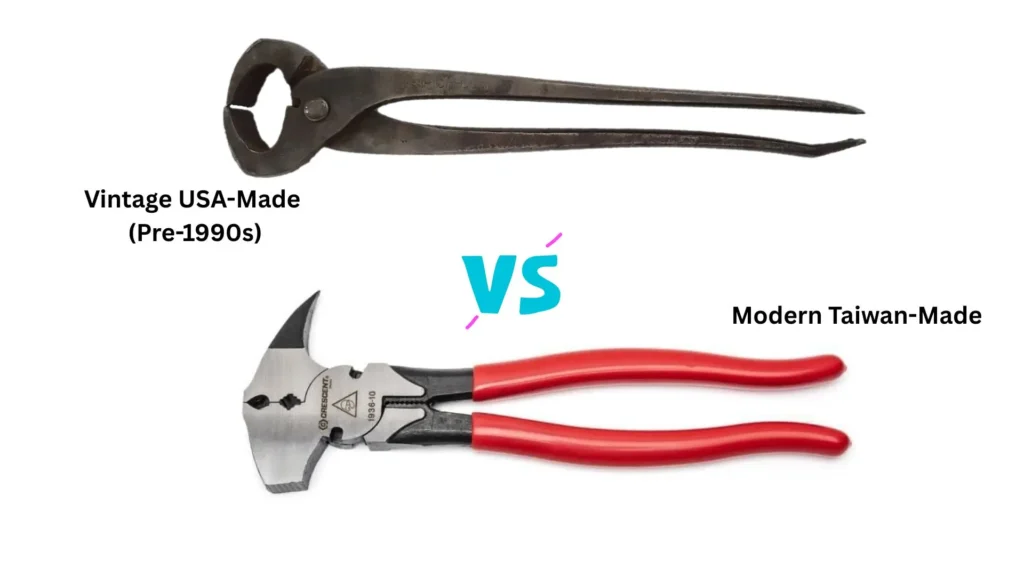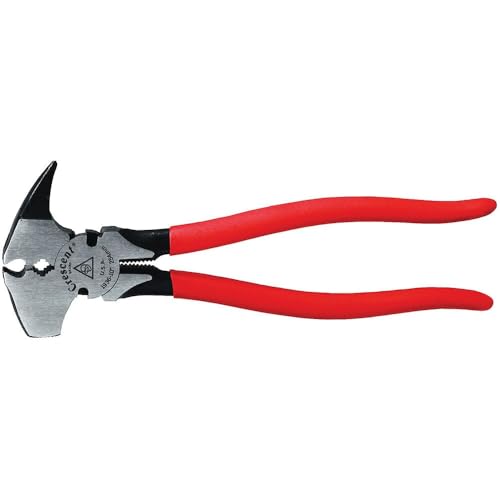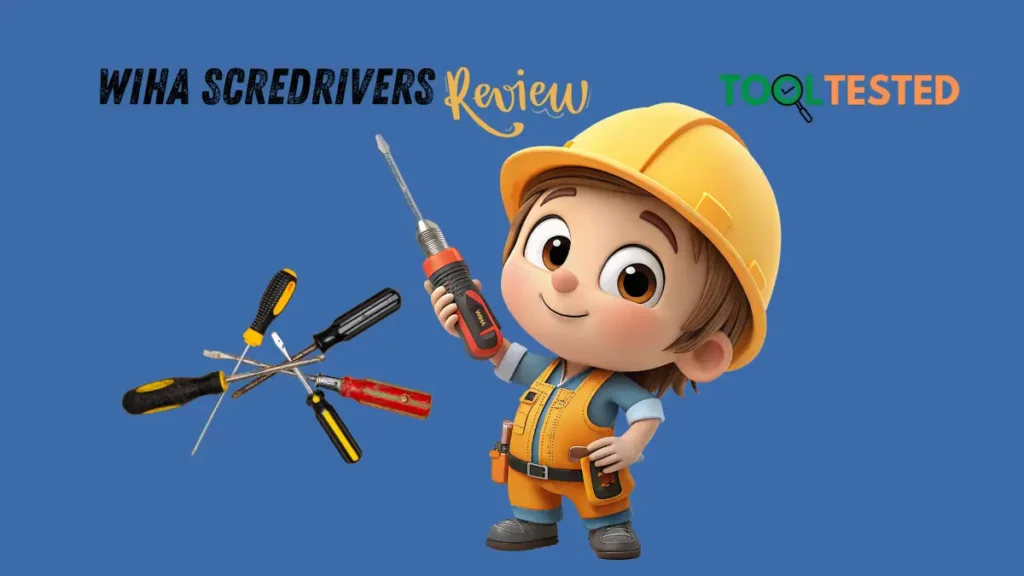Crescent fencing pliers remain essential tools on American farms and ranches. Many users still rely on their models from the mid-90s and won’t use anything else.
These workhorses are made from forged alloy steel and come with electronically hardened wire cutters and a special wire wrapping groove. But there’s an ongoing debate about their quality these days. Many longtime users point out clear differences between the older USA-made models and newer ones manufactured in Taiwan.
The 10-inch model stands out as the gold standard for fence building. Its corrugated hammerhead and non-slip handles make it a favorite. Professional fence builders rate these pliers among their best tools, especially when they need precise handling of high-tensile wire.
Modern fencing equipment like cordless staple guns can cost up to $1,820. This makes us look at whether these classic pliers still offer the value they’re famous for. Let’s take a closer look at what makes these tools special—and if they deserve space in your toolbox.
Affiliate Disclosure
Hi, everyone; this is a heads-up about affiliate links you might see here. Our only purpose in including them is to help you find products easily if you are interested. There is no pressure to buy from these links, but also note that if you buy the products from these links, we may earn a small commission (at no extra cost to you). Your trust is important to us!
Learn more by reading our Full Disclosure.
Price Disclaimer
If we mention prices on Tool Tested, please keep in mind that prices can go up or down based on factors such as location, store policies, and whether the purchase is online or from a physical store. Each seller may have their own pricing structure.
Another important factor to consider is that the price we mention is based on the date of our review. It is possible that we purchased the tool long before that date, or that you are reading this review a long time after it was published, meaning the price may have changed.
We understand some readers like to see the product in action immediately. If that’s you, you can click the direct link below to check it out!
- Strong Crescent Pliers: These heavy-duty pliers are crafted from forged alloy tool steel, ensuring superior strength and…
- Ergonomic Cutting Pliers: With a dipped handle designed for ergonomic ease, continuous use is more comfortable, reducing…
- Precision Wire Cutter: This cutter tool features an electronically induction-hardened wire cutter, ideal for cutting, gr…
Note: The purpose of adding this product as an affiliate is just for your comfort so that if you want to check the details and authenticity of our review the above Product will help you for that.
Crescent Fencing Pliers: Design and Build Quality
First made from forged alloy tool steel, Crescent fencing pliers became an essential multi-purpose tool for fence builders. The classic 10″ design comes with a corrugated hammer head, two electronically induction-hardened wire cutters, and a heavy prong designed to pull out rusty staples easily. These pliers feature a special opening in the head that grips both wire and staples securely. A wire grip between the handles helps stretch wire—this sets them apart from standard pliers.
Rise of the Classic 10″ Fencing Pliers
Swedish immigrant Karl Peterson started the Crescent Tool Company in 1907. The company grew bigger after buying Smith & Hemenway in 1926 and added many new plier designs. Today’s fencing pliers were built specifically for wire fencing maintenance and packed multiple tools into one reliable package. Crescent launched their “Crestoloy” line of alloy steel tools in 1930, which made them much more durable.
Materials and Manufacturing: USA vs. Taiwan Models

The quality difference between American-made and overseas models stands out. Many pros say that USA-manufactured versions, especially pre-1990s models, last longer under heavy use. A user switched to Taiwan-manufactured models and found the cutters rolled over after just 50 meters of repairs with 2.5mm high-tensile wire. Modern Crescent fencing pliers are made in Taiwan using forged alloy steel. Their polished head helps fight corrosion.
Handle Ergonomics and Grip Options
Crescent gives you three main grip choices:
- Dipped handles that clean easily and resist wear
- Cushioned non-slip grips that stay comfortable longer
- Professional steel handles with knurled patterns that work better with gloves
Weight and Balance Considerations
These pliers weigh 1.2 pounds and measure about 10-7/16 inches long, giving them good heft without tiring you out. The jaw’s size (1-1/16 inch length by 3-5/8 inch width) helps you control wire better, so you can work precisely even on delicate tasks. The angled head makes offset cutting more efficient—a key feature when working with different fencing materials.
Performance Testing with Different Fencing Materials
To see what these Crescent fencing pliers can really do beyond the specs, I put the modern 10-inch model through its paces here at the workshop using common fencing materials. Professional fence builders I consulted confirm these multi-function tools adapt well to various tasks, though performance naturally varies by model and the specific job at hand. Let’s look at how they held up on key functions.
Cutting Capability on Barbed and High-Tensile Wire
These pliers feature electronically induction-hardened cutting edges that work great on standard fencing wire. Each model comes with different cutting capacities—from 11 AWG to 12 AWG. Users confirm these tools handle barbed wire well, and they cut through high-tensile wire without much trouble. All the same, heavy use on high-tensile wire will dull the cutting edges eventually, but they last longer than most competitor brands.
Staple Pulling Efficiency
The curved head design gives you great leverage to pull stubborn staples from fence posts. You’ll find the heavy prong on the head pulls out rusty staples easily—a feature users call “indispensable”. The special head opening lets you grip both wire and staples at once, which makes pulling them out much faster.
Wire Wrapping Groove Functionality
The rounded end’s groove excels at gripping and twisting fence wire. Combined with teeth at the nose tip, this feature lets you handle wires with precision during fence building and repairs. Users particularly like how it attaches clips to t-posts, showing its value beyond simple cutting and pulling tasks.
Hammer Function Performance
The hammer function gets mixed feedback despite its versatile design. While it works fine for driving staples and small nails, the hammer head tends to flatten under heavy force. Most pros suggest using it just for light hammering instead of replacing your regular hammer. The corrugated hammer head still provides decent grip when driving nails or staples into wooden fence posts.
Comparing Vintage vs. Modern Crescent Models
Collectors and professional fence builders have long debated whether vintage Crescent fencing pliers work better than modern ones. The rise of this iconic tool shows interesting changes in how well they’re made and what matters most in their design.
The Sought-After Pre-1990s USA-Made Versions
Vintage Crescent fencing pliers from Jamestown, NY are worth a lot more now since the company was bought in 1960. These American-made tools from before the 1990s now sell for $35-45 on auction sites. Crescent started as a family business until 1960 when investors bought it and created the Crescent Niagara Corporation. The most valuable models use “Crestoloy” steel—a special alloy steel that Crescent started making in 1930. This steel stays sharp longer and lasts much longer than regular steel.
Key Differences in Newer Production Models
Modern Crescent fencing pliers look quite different now. The company makes them in Taiwan instead of the USA, which marks a big change from their American roots. Today’s models still keep the classic design with:
- Forged alloy tool steel construction
- Electronically induction-hardened cutting edges
- Dipped or cushion grip handles that feel better to hold
The newer models have better grip and won’t slip as easily, but they’re not built as heavy as the old ones. On top of that, fence builders say the steel hardness feels different between old and new tools.
Durability Comparison After Extended Use
Real-world testing shows clear differences between old and new Crescent pliers. The USA-made models keep their sharp edges even after years of heavy use. But users say the newer Taiwan-made versions wear out faster, especially when they cut high-tensile wire.
The vintage models’ pivot joints stay tight, and their hammerheads hold up better than the new ones. Without doubt, this explains why many professionals still hunt for pre-1990s models, even though the manufacturer says new ones are just as good.
Crescent tools built their name on quality and reliability—a reputation that still affects how people choose between old and new models today.
Value Assessment: Price vs. Longevity
Quality fencing tools are worth the investment and pay off in the long run. The upfront cost becomes less important for serious fence builders. The balance between the original investment and reliability needs attention at the time of perusing Crescent fencing pliers.
Original Investment Compared to Competitors
Crescent fencing pliers cost between $25.99 and $39.99, based on the model and where you buy them. These prices make Crescent a mid-range choice that gives great value compared to premium European brands. The tools become more available with retailer discounts up to 31% off regular prices. The price stays competitive because these pliers work as multiple tools in one.
Long-Term Durability Factors
Crescent makes these fencing pliers from forged alloy steel to last longer. The electronically induction-hardened, hand-honed cutting edges stay sharp after heavy use. Tool maintenance is a vital part of making them last. Simple steps like cleaning and oiling the pivot points can make them last by a lot.
“Investing in high-quality fence pliers now can save you money and frustration in the long run”. This fence builder’s experience shows how quality tools are a great way to get better value through longer service life, even with higher original costs.
Warranty Coverage and Customer Support
Crescent’s warranty makes their fencing pliers stand out. Their “No B.S. Lifetime Warranty” covers manufacturing defects whatever the tool’s age. The policy includes:
- No receipt is required for warranty claims
- Replacement is hassle-free for qualifying products
- Shipping costs for replacements are covered by Crescent
The warranty doesn’t cover misuse, abuse, or accidental damage[183]. Crescent’s customer service team knows how to help you pick tools and handle warranty claims.
Professional Alternatives to Consider
Crescent fencing pliers are great for many tasks, but some fencing jobs just need different or extra tools. Fence builders with experience know that having more tools in their kit helps them tackle specific challenges better.
When Lineman’s Pliers Might Be Better
Lineman’s pliers can work better than regular fencing pliers, especially with electrical parts or thinner wires. Many pros can work faster with lineman’s pliers than fencing pliers. Knipex linesman pliers give you great leverage to cut barbed wire, though regular versions are often too small for heavy wire cutting. DeWalt lineman’s pliers are useful in a variety of jobs beyond fencing. They’re a smart buy if you do lots of maintenance work.
Specialized Tools for Specific Fencing Tasks
HT wire cutters work great with fencing pliers on high-tensile wire projects. Wire crimping tools let you join metal pieces without welding, which helps fix metal fences reliably. Seymour Hog Ring Pliers come with slip-resistant jaws that make chain link installation easier. Electric fences work better with special tools like voltage testers and insulators that help spread the electrical charge properly.
Best Complementary Tools for Complete Fencing Kit
A complete fencing toolkit has tools that go beyond what fencing pliers can do. Klein Tools Haven Grip can handle 2500 lbs and makes wire tensioning substantially easier. A good come-along helps put the right tension on fence sections so wires stay straight and properly arranged. You’ll always need a post-hole digger – some even come with rulers to measure depth exactly. Most fence pros use a tamping tool with their fencing pliers to secure posts firmly.
The Malco 10″ Fence Pliers are worth their $49.99 price tag for chain-link fence work. They come with three built-in wire cutters that can handle up to 9-gage wire.
Conclusion
The sort of thing I love about Crescent fencing pliers is their legendary status, though vintage USA-made models outshine the newer Taiwan-manufactured versions. These tools still pack remarkable value based on my research. You get a multi-functional design that cuts wire, pulls staples, and works as a light hammer all in one.
Professional fence builders will find the $25-40 price tag reasonable, especially when you have Crescent’s complete lifetime warranty. Modern versions might not match those pre-1990s models’ exceptional durability, but they still beat many competing brands in real-life tests.
The classic 10-inch design remains a reliable workhorse for both pros and DIY fence projects, despite changes in manufacturing. All the same, serious fence builders should think about adding specialized tools like dedicated wire cutters or crimping tools to their arsenal.
My full picture shows that Crescent fencing pliers are a must-have in any fence builder’s toolkit. Their versatility, decent build quality, and competitive pricing make them perfect for most fencing projects – just keep expectations realistic compared to their vintage counterparts.




